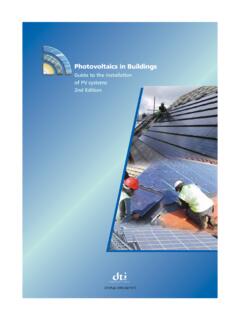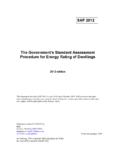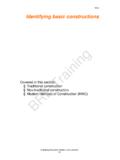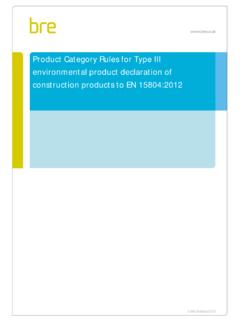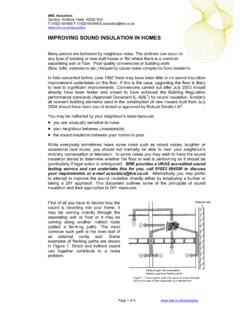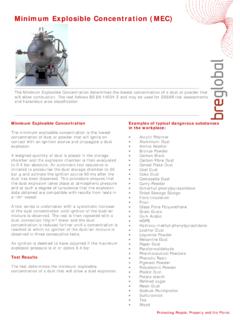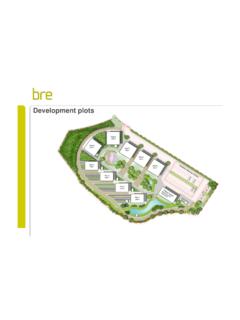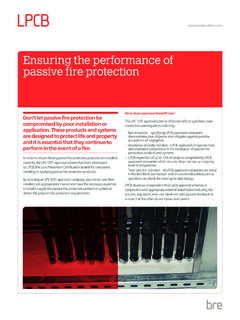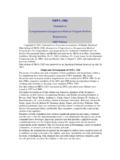Transcription of Conventions for U-valuecalculations - BRE
1 Conventions forU-value calculations 2006 editionBrian Anderson BRE Scotland BREis committed to providingimpartial and authoritativeinformation on all aspects of thebuilt environment for clients,designers, contractors, engineers,manufacturers and owners. Wemake every effort to ensure theaccuracy and quality of informationand guidance when it is , we can take noresponsibility for the subsequentuse of this information, nor for anyerrors or omissions it may is the UK s leading centre ofexpertise on the built environment,construction, sustainability, energy,fire and many associated BRE for information aboutits services, or for technical advice:BRE, Garston, Watford WD25 9 XXTel: 01923 publicationsare Press (IHS ATP)Willoughby RoadBracknell RG12 8 FBTel: 01344 328038 Fax.
2 01344 to copy any part of thispublication should be made to thepublisher: BRE PressGarston, Watford WD25 9 XXTel: 01923 443:2006 BRE 2006 First published 2002 Second edition 2006 ISBN 1 86081 924 9 AcknowledgementsThe work carried out under this project was funded by industry and theDepartment for Communities and Local Government, organisedthrough the Construction Products 1 Introduction12 Numerical methods and simplified and simplified methods used bridging at junctions and around openings33 Thermal properties of materials and of thermal properties of for use in beams and concrete and conductivity of other Reflective foil Bubble sheet with aluminium foil facing6 Multi-foil insulation64 Issues concerned with U-value joints in masonry masonry fraction for timber-framed timber fraction for other timber wall on
3 On airspaces, normal (high) airspaces, low emissivity metal to thermal due to air screws and other discrete and masonry support light that may be disregarded in U-value Metal-faced roofing and wall Light steel-framed walls175 Elements adjacent to an unheated space186 Expression of results187U-values for walls198U-values for roofs219U-values for floor (ground-bearing floor slabs) timber beam-and-block beam floor with polystyrene between the beams or below the beams, or suspended floor precast concrete suspended floor composite steel and exposed on underside2610U-values for Heated Unheated basements2711U-values for windows, roof windows and Roof windows and rooflights2912U-values for doors30 Appendix A: Elements adjacent to an unheated space31 Appendix B.
4 U-values of uninsulated floors35 References and further reading36iv1 IntroductionCalculation methods for the determination of U-values of building elementsare based on standards that were developed in the European Committee forStandardisation (CEN) and the International Organisation for Standardisation(ISO) and published as British methods are appropriate for demonstrating compliance withbuilding regulations for the conservation for fuel and power, namely Part L ofthe Building Regulations for England & Wales, Section 6 of the Building(Scotland) Regulations, and Part F of the Building Regulations (NorthernIreland)[1,2,3].
5 Where compliance is expressed in terms of whole-buildingperformance, such as CO2emissions, U-values obtained by the methodsreferred to in this document should be used for the relevant calculations bythe Standard Assessment Procedure (SAP)[4]for dwellings or by the SimplifiedBuilding Energy Model (SBEM)[5]for other publication provides guidance on the use of the calculation methodsby: indicating the method or methods of calculation that are appropriate fordifferent construction elements; providing additional information about using the methods; providing data relevant to typical UK does not reproduce the details of the calculation methods, for which thereader is referred to the relevant British Standards and other referencedocuments (see References and further reading).
6 While calculated U-values are acceptable for Building Regulations and mostother purposes, direct measurement of U-values is also possible and, indeed,test results should be preferred when available provided that the values havebeen obtained in accordance with the appropriate measurement standards*.The guidance in this document is concerned with the U-values of buildingelements walls, roofs, floors, windows and doors. It is complementary tothe information in Accredited Construction Details[6]which deals with thejunctions between building elements and around is given on: thermal conductivity of materials (section 3); various issues that commonly arise when undertaking U-value calculations(section 4); various types of construction element, identifying which of the issuesmentioned in section 4 apply to which construction type (sections 7 to 12).
7 1*The measurement standards for the U-value of building components are BS EN ISO 8990 forwalls, roofs, and floor decks (ie excluding effects of the ground), BS EN ISO 12567-1 forwindows and doors, and BS EN ISO 12567-2 for methods andsimplified methodsU-value calculation is at its simplest for a building element which consistssolely of plane, parallel, uniform layers: the heat flow through such an elementis directly from inside to outside in a straight line, and all that is needed toobtain the U-value is a simple sum of the thermal resistances of each all practical building components, however, have non-uniformities,whether they be joints between masonry units, timber joists with insulationbetween them, other types of structural member separated by infill panels,glazing within a frame, and so on.
8 The consequence of non-uniformities, orthe presence of any layers that are not plane and parallel, is that the heat nolonger travels in straight lines. That affects the total heat transfer through theelement and needs to be allowed for in the determination of the Numerical methodsThe term numerical method or numerical analysis is used in this guide toindicate a detailed computer calculation that allows for multi-dimensional(non-uniform) heat general case involves variations in heat flow in all three dimensions,and would be invoked for analysis of 3-way corners between buildingelements, for instance.
9 For the purposes of U-values, however, it is almostalways the case that the construction is uniform in one direction or that 3-dimensional (3-D) effects do not significantly affect the overall U-value. (The corners of a window frame represent an example of the latter.) Inconsequence, 2-D analysis much easier to visualise and to represent withincomputer software is appropriate for most cases of U-value are cases, however, which need to be treated in a 3-D way (eg pointfixings).Various mathematical techniques can be employed, including finite elementanalysis, finite differences, and boundary integral methods.
10 Softwarepackages based on any of these techniques are suitable for numericalanalysis provided that they conform with BS EN ISO 10211 and, in the case ofwindows and doors, BS EN ISO analysis provides the most precise results, and is always apermissible alternative. Many cases, however, can be treated by simplifiedmethods for which the calculation procedures are much easier to carry is important that numerical analysis is carried out using appropriatesoftware and by persons who have adequate experience of undertaking thistype of calculation. A guidance document is in preparation[7].
